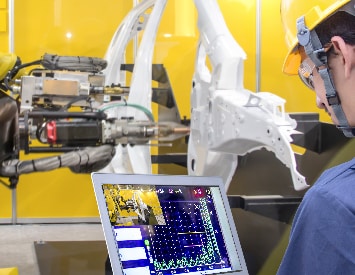Getting Optimum Performance through Feedwater Control Valve Modifications
Brian Leimkuehler, P.E.
(Presently at ComEd, LaSalle County Nuclear Station)
Sanjay V. Sherikar, P.E.
CCI
22591 Avenida Empressa
Rancho Santa Margarita, CA 92688
FROM: Sixth EPRI Valve Technology Symposium
July 14-16, 1997
Portland, Maine
Abstract
Good control of the feedwater system is very important for smooth operation at nuclear power plants. The performance of the feedwater control valves, which are the final control elements, is crucial in achieving the desired level of control in the system. Modifications were made to existing feedwater control valves at a 565 MWe BWR nuclear power plant. These modifications were part of an overall system upgrade, resulting in significantly improved controllability of the Feed Water Control system. The characteristics that are critical for best performance from the feedwater control valves are : fluid velocity control at all operating conditions, high rangeability, proper flow characterization, high actuator stiffness and good dynamic response. By analysis, and observed through experience, a properly designed and maintained pneumatic control system can provide the dynamic response and resolution necessary for feedwater control performance.
Introduction
Typical loops for the main working fluid in boiling water reactors (BWR’s) and pressurized water reactors (PWR’s) are shown in Figures 1a and 1b, respectively. While the two types of nuclear power generation are quite different, there are many similarities concerning the control of the feedwater being fed into the steam generator, or reactor. In both types of plants, smaller startup, or bypass, valve is quite common because conventional valves do not have the high rangeability required for feedwater control service. This type of service can lead to oscillating control problems during transfer from the startup valve to the main valves, which may cause plant to trip. In both these systems, maintaining fine level control in the reactor, or steam generator, is essential. Finally, the feedwater control valves are required to have good responsiveness to recover from transients. Thus, the performance of the feedwater control valves is critical to all nuclear plant performances.
In this paper, the original feedwater control valves at a 565 MWe BWR nuclear power plant are described, along with their characteristics and performance. Following are the modifications made to the feedwater control valves to enhance their characteristics and how the changes affected the overall system performance.
Original Feedwater System
This plant had been in operation for about 24 years when the system modifications were initiated. The feedwater control valves in service since the commissioning of this plant are “velocity control” valves with tortuous flow path trim.
Feedwater Control Valves
A typical configuration of a velocity control valve is shown in Figure 2. Description and characteristics of this type of valves can be found in previous publications (ref. 1,2 and 3). One of the special features of these types of valves is the trim design in which control of fluid velocities is maintained under all operating flow conditions. This approach practically eliminates cavitation which is likely to occur during startup, or under low flow conditions, when the DP across the valve is significantly higher than normal flow conditions. Essentially, the trim is made up of disks which are multi-stage, multi-path flow controlling elements. Each disk has a tortuous flow path consisting of many right angle turns, each of which provides a discrete pressure-reducing stage. The disk stack formed from these disks forms a multi-path cage as shown in Figure 3.
Since each disk can be unique, the overall flow versus stroke characterization for the valve can be customized for individual applications. In the case of feedwater control valves, fine control is required at low flows and high DP’s and, at full load, with high flow low and DP. In the disk stack such as one shown in Figure 3, this is easily accomplished by incorporating disks with large number of turns for low flow conditions, and by incorporating low number of turns, or no-turns, for the high flow end.
Other significant benefits of controlling fluid velocity at all operating conditions is elimination of excessive vibration, noise, and erosion of the trim and body. These problems are common in valves of conventional designs where trim exit velocities are not controlled.
Characteristics of the Original Control Valves
The trim of the original feedwater control valves was a combination of “velocity control” disk stack with a cage on top. The trim was designed so that the valve would operate under normal conditions within the range of the disk stack; however, to handle transients, the valve could open into the caged area. The Cv versus stroke characteristics of the valve, shown in Figure 4, indicates the abrupt slope changes at the transition from disk stack to the cage.
Additionally, there is a transition zone between the disk stack and the cage area where flow control is unresponsive and creates controller problems to maintain steady flow around the transition zone. When the power plant decided to do a power uprate, a corresponding increase in feed flow was required. This increase in flow caused the valve plugs to control flow in the transition zone of the trim and lead to flow oscillations at full power. As a result, the controllability of feedwater flow was poor. This, in turn, led to fluctuations in reactor level and caused reactor power to be reduced farther below the allowable thermal limits which then causes a reduction in power plant efficiency and power output.
The original valve actuators were 200 sq.in. pneumatic, double-acting piston type with internal springs and equipped with positioner, lockup valves and volume boosters. This type of actuator has been known for their reliability, simplicity and ease of maintenance. However, the large chamber required to accommodate the spring results in limited actuator stiffness. This impacts resolution which, in turn, affects the smallest step change that the valve position, or flowrate, can be achieve.
Enhancing Feedwater System Performance - Control Valve Modifications
This plant undertook multiple changes for enhancing the feedwater control system performance. The major contributors towards improving the feedwater control valve characteristics were improved flow characterization and increasing pneumatic stiffness. Other improvements were in the designs of the plug assembly design, bonnet, yoke, positioner and pneumatic controls. All the upgrades were installed without any changes to the design of the existing valve body.
Cv versus Stroke Characterization
A new “full range” disk stack replaced the original disk stack and cage combination. The new trim has essentially the same overall capacity (Cv) in the full open position as before. However, the new stack was characterized to minimize the rate change between normal and transient areas. Also, the transition zone was eliminated. The characteristics of the valves with new trim is shown in Figure 5.
The disks in the new stack were designed for trim exit velocities under 100 ft/s, as before, to eliminate the potential for cavitation, vibration, noise and other associated problems over the entire range of operating conditions.
Actuator Pneumatic Stiffness
The actuator type was changed to a low-volume actuator while keeping the piston area the same. In this type of actuator, the volume of the air inside the actuator above and below the piston is minimized by removing the internal spring. As a result, the actuator becomes much stiffer.
The governing equations of actuator stiffness, and its relationships to valve resolution are defined below.
Referring to Figure 6, the spring constant (stiffness), K, of pneumatic piston actuator is given by
K = 1.4 *A*{P1/L1 + P2/L2 + Ks} (1)
where, A is area of the piston, P1 and P2 are pressures in the lower and upper chambers of the actuator respectively, L1 and L2 are the equivalent lengths of the air volumes in the lower and upper chamber, and Ks is the stiffness of the internal spring. L1 and L2 are defined by,
L1 = V1/A (2a)
L2 = V2/A (2a)
where, V1 and V2 are the air volumes in the lower and upper chambers of the actuator respectively.
This leads to position resolution, Dx, that the valve can achieve as given by
Dx = {Fs - Fd}/K (3)
Fs and Fd are the sums of static forces and the sums of dynamic forces, respectively, that act on the plug. From Equation (1), actuator pneumatic stiffness can be modified by changing any of the variables. However, in practice, the only parameters that makes the biggest changes are piston area (A) and equivalent lengths (L1 and L2) in the chamber. In this case, the piston area was maintained while changing the actuator length to a low-volume actuator. The stiffness for the original actuator and the new actuator are shown in Figure 7. The high values of stiffness that can be achieved show that a properly designed pneumatic actuator is capable of fine resolution control, as in applications for feedwater control valves.
Figure 8 shows typical resolution for the new low-volume actuators when compared with the original actuators, based on Equation (3). Note that the resolution indicated is the capability of the valve and the actuator combination only; in practice, the sensitivity of the positioner and other control elements providing signal to the valve also affect the resolution.
Rangeability
The rangeability of the feedwater control valves is the ratio of the maximum Cv to minimum controllable Cv. The rangeability with the new trim is 170:1 which is comparable to that for the old trim. Such high rangeability allows for a better overlap between the startup valve and the main feedwater control valves during transitions between the two valves.
Other Modifications
A new standard designs for plug assembly, bonnet and yoke significantly improved structural rigidity in the feed water control valves. A new packing configuration consisting of 8 rings of larger OD replacing the original set of 33 rings, eliminated packing leaks during plant shutdown. In addition, the old positioner was replaced by a new type of positioner with simplified controls which resulted in lower maintenance and no drifting.
Results
Since the installation of the upgrades to the original valves, the system operation has improved significantly. The overall enhanced performance is a result of modifications to the feedwater control valves, actuators and controls. The gains in performance due to the actuator upgrades alone are indicated by the reduction in vessel level oscillations, from about 2” peak-to-peak to 1” peak-to peak, and reduction in feed pump discharge pressure oscillations (Figures 9 and 10). During a refueling outage, the valve trim was upgraded and the control system was modified; this resulted in additional oscillation reduction in reactor level, down to about 0.5” peak-to-peak, feed water flow, and eliminated all of the differential pressures between the two feed pump discharges (Figures 10 and 11).
As shown in Figure 8, the resolution of the actuators at full load is significantly better when compared to what was achievable before. In operation, overall resolution of 0.62% was noted. This level of accuracy in positioning allows for fine control of the water level in the reactor.
With the smoothing out of the disk stack characterization, elimination of abrupt flow regions and transient zone have resulted in stable control over the entire range of the valve operations.
The plant has reported “nearly straight-line control” of reactor level, as desired and has practically eliminated all power fluctuations. This allows operation closer to the allowable thermal limit and a small corresponding increase in power.
These results stated above are consistent with the experiences at number of other nuclear power plants, including pressurized water reactors (PWR’s). In each of the cases, proper rules of fluid velocity control, flow versus stroke characterization, high rangeability and stiff pneumatic actuation systems have eliminated feedwater control valve problems.
The new packing configuration has improved reliability in terms of preventing leakage especially during shutdown conditions. Ease of calibration and practical elimination of drift are two benefits realized from the positioner change. Finally, the modifications of pneumatic controls improved dynamic response of the valve enabling it to better respond to transients.
Conclusions
Improving the control valve characteristics significantly enhanced the feedwater system performance. The significant improvements in valve performance were achieved by modifying the valve flow characterization, increasing the actuator pneumatic stiffness, and by understanding and maintaining the actuator system.
The feedwater control valves are reported to operate quietly over the entire range and with considerable less vibration than before. This is attributed to the controlling of trim exit velocities below 100 ft/s, and increased actuator components rigidity.
A properly designed feedwater control valve, with high rangeability, allows for a better overlap between the startup valve and the main feed water control valves during transitions between the two valves. In some cases, use of the startup valve may not be required if the rangeability of the main feed water control valves is adequate.
As proven by this utility, a properly designed and maintained pneumatic controlled feed water valve system can meet the requirements of providing the resolution and responsiveness needed to maximize power plant efficiency and minimize operational problems.
References
- Brailey, E.J. and Miller, H.L. High Differential Pressure Control Valves to Limit Temperature Swings. Power Engineering, April 1991, pp. 47-50. [industry magazine]
- Miller, H.L. Controlling Valve Velocity. INTECH/Instrument Society of America, Research Triangle, NC, May 1993, pp. 22-24. [ISA magazine]
- Rahmeyer, W.J., Miller, H.L., and Sherikar, S.V., Cavitation Testing Results for a Tortuous Path Control Valve. ASME FED-Volume 210, Cavitation and Multiphase Flow, 1995, pp. 64-67. [Conference proceedings]





